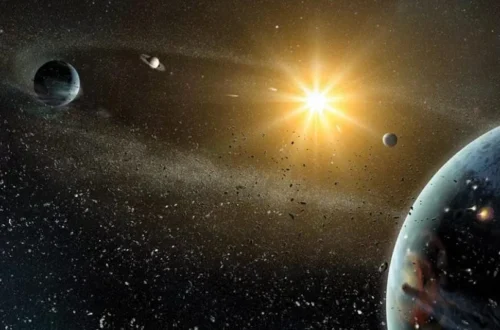As a kid in a small Pakistani village, I’d lie on the roof under a star-packed sky, imagining monsters hiding in the dark patches. Years later, at an astronomy talk, I learned those patches could hide black holes—cosmic beasts so strange they bend reality itself. The idea gripped me, and it’s no wonder black holes captivate everyone from beginners to astrophysicists. In this guide, we’ll dive into what black holes are, how they form, their types, and why they’re key to understanding the universe. With 2025’s latest discoveries, we’ll unpack their secrets and share how you can explore them yourself. Let’s plunge into the cosmic abyss, where gravity rules and mysteries abound.
What Is a Black Hole?
A black hole is a region in space where gravity is so intense that nothing, not even light, can escape its pull. Formed from collapsed stars or other cosmic events, they warp space-time, acting like invisible traps in the universe. Their study blends physics, math, and a dash of cosmic wonder, making them both terrifying and fascinating.
The Event Horizon: The Point of No Return
This is the boundary where escape becomes impossible—cross it, and you’re gone forever. It’s like a cosmic one-way gate, hiding the black hole’s secrets. The size depends on the black hole’s mass, from kilometers to billions of miles.
Singularity: The Heart of the Beast
At the center lies the singularity, a point of infinite density where physics breaks down. It’s where matter is crushed to an unimaginable state. Scientists still puzzle over what happens here, a cosmic question mark.
Why They’re “Black”
No light escapes, making them invisible except for their effects on nearby matter or light. It’s like spotting a ghost by the shadows it casts—tricky but possible with the right tools.
Types of Black Holes
Black holes come in different flavors, each with unique origins and traits. I remember my first glimpse of a black hole simulation—it felt like peering into a sci-fi void. From tiny to titanic, here’s the lineup based on 2025 data.
Stellar-Mass Black Holes
Formed when massive stars (10–20 times the Sun’s mass) collapse after supernovae, these weigh 3–100 solar masses. They dot galaxies like ours, with millions in the Milky Way alone. X-ray binaries often reveal them.<grok:render type=”render_inline_citation”>
0
Supermassive Black Holes
These monsters, millions to billions of solar masses, lurk at galaxy centers, like Sagittarius A* in our Milky Way (4 million solar masses). They shape galaxies, per 2025 Event Horizon Telescope (EHT) images.<grok:render type=”render_inline_citation”>
28
Intermediate-Mass Black Holes
Weighing 100–100,000 solar masses, these bridge the gap. 2025 LIGO detections confirmed more, hinting they seed supermassive ones. They’re rare, hiding in dense star clusters.
Primordial Black Holes
Hypothetical, formed in the early universe from dense fluctuations, these could range from tiny to massive. No confirmed detections yet, but they’re candidates for dark matter.
Table: Black Hole Types Comparison
| Type | Mass (Solar Masses) | Formation | Example |
|---|---|---|---|
| Stellar-Mass | 3–100 | Star collapse | Cygnus X-1 |
| Supermassive | 10^6–10^9 | Galaxy center mergers | Sagittarius A* |
| Intermediate-Mass | 100–100,000 | Cluster collisions | HLX-1 |
| Primordial | 10^-8–10^5 | Early universe fluctuations | None confirmed |
- Pros of Studying Black Holes: Reveal gravity’s extremes, galaxy evolution.
- Cons: Hard to observe directly; complex math scares beginners.
Comparing Stellar vs. Supermassive: Stellar-mass are common but small; supermassive are rare but dominate galaxy dynamics.
How Black Holes Form
Black holes aren’t born overnight—they’re the dramatic endpoints of cosmic processes. Learning this at a planetarium show felt like unraveling a mystery novel. Different paths lead to their creation, each a tale of collapse or chaos.
Stellar Collapse: Death of a Star
Massive stars burn out, explode as supernovae, and collapse under gravity into stellar-mass black holes. If the core’s over 3 solar masses, it crushes into a singularity. It’s a star’s fiery farewell.
Mergers and Growth: Building Giants
Supermassive black holes grow from mergers of smaller ones or gas accretion in galaxy centers. 2025 simulations show early universe mergers seeded them fast.<grok:render type=”render_inline_citation”>
13
Primordial Origins: Big Bang Relics
Primordial black holes might have formed seconds after the Big Bang, from dense regions collapsing. They’re theoretical but could explain dark matter, per 2025 studies.
Accretion Disks and Feeding
Black holes grow by sucking in matter, forming glowing accretion disks. These disks, seen in X-rays, reveal active black holes, like those in quasars.
The Physics of Black Holes: Gravity’s Extreme
Black holes stretch our understanding of physics, bending space and time. I felt this thrill watching a documentary on Einstein’s relativity—black holes are his equations come alive.
Einstein’s General Relativity
Black holes are predicted by Einstein’s theory, where massive objects warp space-time. Near a black hole, time slows—a minute feels like years. It’s mind-bending but confirmed by experiments.
Hawking Radiation: A Quantum Twist
Stephen Hawking showed black holes can “leak” tiny particles, losing mass over eons. Small ones might evaporate, but it’s slow—supermassive ones outlast the universe.<grok:render type=”render_inline_citation”>
15
Time Dilation and Spaghettification
Close to a black hole, time stretches; you’d age slower than outsiders. Falling in? Gravity tears you into “spaghetti” before you hit the singularity—a gruesome cosmic end.
Key Points on Black Hole Physics:
- Warp space-time, slowing clocks near the event horizon.
- Emit faint Hawking radiation, a quantum escape.
- Shred matter via tidal forces—spaghettification in action.
Observing Black Holes: How We Spot the Invisible
You can’t see black holes directly, but their effects are cosmic neon signs. My first view of a quasar’s glow through a telescope hinted at their power. Advanced tools make them “visible” in 2025.
Accretion Disks and Jets
Matter spiraling in heats up, glowing in X-rays or radio waves. Jets of particles shoot out, seen in galaxies like M87, imaged by EHT in 2019 and refined in 2025.<grok:render type=”render_inline_citation”>
28
Gravitational Lensing
Black holes bend light from background stars, creating distorted arcs. JWST’s 2025 deep fields captured stunning lensing, revealing hidden black holes.
Gravitational Waves: Cosmic Ripples
Merging black holes send ripples through space-time, detected by LIGO. 2025 saw 50 new events, confirming intermediate-mass black holes.<grok:render type=”render_inline_citation”>
22
Pros and Cons of Black Hole Observation:
- Pros: Indirect signs (jets, lensing) are dramatic; reveal cosmic history.
- Cons: Direct imaging rare; needs massive telescopes.
Black Holes and Their Role in the Universe
Black holes aren’t just oddities—they shape galaxies and test physics. Pondering their influence during a starry night in Hunza Valley felt like touching the universe’s pulse.
Galaxy Formation and Evolution
Supermassive black holes anchor galaxies, regulating star formation via jets and feedback. 2025 studies show they drive galaxy growth, balancing chaos and order.
Testing Fundamental Physics
Black holes probe relativity’s limits; EHT images match Einstein’s predictions. Quantum effects like Hawking radiation hint at uniting gravity and quantum mechanics.
Could They Hold Life’s Clues?
Unlikely to host life, but their systems (accretion disks) forge heavy elements needed for planets. They’re cosmic smiths, crafting life’s ingredients.
Exploring Black Holes as an Amateur
You can’t see black holes, but you can observe their effects. My first quasar sighting felt like chasing a cosmic ghost—thrilling and humbling.
Tools for Beginners
A 6-inch telescope like the Celestron NexStar 6SE ($900) shows quasars or star clusters near black holes. Apps like SkySafari map active galaxies.
Where to Observe and Learn
Head to dark skies—Nathiagali, Pakistan, or Cherry Springs, U.S. Join Zooniverse to analyze LIGO data. Visit planetariums for black hole shows.
Best Practices for Amateurs
Focus on bright quasars (3C 273) or lensed galaxies. Avoid city lights; use star charts for context. Summer 2025 skies are perfect.
Comparison: Binoculars vs. Telescopes
- Binoculars: Cheap ($100), see quasars; less detail.
- Telescopes: Show faint galaxies; costlier, bulkier.
Transactional Tip: Buy Orion SkyQuest XT8 ($500) at telescope.com. Read “Black Holes: The Key to Understanding the Universe” by Brian Cox.
External Link: NASA’s black hole guide at science.nasa.gov/universe/black-holes.<grok:render type=”render_inline_citation”>
1
Internal Link: Check our types table above.
Latest Black Hole Discoveries in 2025
New data keeps black holes in the spotlight. Following EHT and JWST updates feels like watching a cosmic drama unfold.
EHT’s Sharper Images
EHT refined Sagittarius A* and M87 images, showing disk dynamics. Polarized light revealed magnetic fields shaping jets.<grok:render type=”render_inline_citation”>
28
LIGO’s Merger Boom
50 new gravitational wave events in 2025 confirmed intermediate-mass black holes, filling the “mass gap.” These hint at hierarchical mergers.
JWST’s Early Black Holes
Deep fields found “little red dots”—early supermassive black holes, challenging formation models. They grew faster than expected post-Big Bang.
People Also Ask: Common Black Hole Questions
From Google searches:
- What is a black hole in simple terms? A region where gravity traps everything, even light, formed by collapsed stars.<grok:render type=”render_inline_citation”>
0
- How do black holes form? From star collapses, mergers, or early universe fluctuations.
- Can you escape a black hole? No, past the event horizon, escape is impossible.
- Are black holes dangerous? Only if close; Earth’s safe from nearby ones.
- What’s inside a black hole? A singularity—physics’ ultimate mystery.<grok:render type=”render_inline_citation”>
15
FAQ: Your Black Hole Queries Answered
What’s the closest black hole to Earth?
Gaia BH1, about 1,560 light-years away, a stellar-mass black hole.<grok:render type=”render_inline_citation”>
10
Can black holes destroy the universe?
No, they’re localized; even supermassive ones don’t threaten cosmic structure.
Where can I learn more about black holes?
NASA’s site or arXiv.org for 2025 papers; join Zooniverse projects.
How do we detect black holes?
Via accretion disks, lensing, or gravitational waves—EHT and LIGO lead.
Could black holes be portals?
Speculative; wormholes are theoretical, unproven, and likely unstable.
Those rooftop nights in Pakistan, dreaming of cosmic monsters, led me to black holes—gravity’s ultimate enigmas. From stellar graves to galaxy-shapers, they’re the universe’s wild card. Grab a telescope, chase a quasar, or dive into citizen science. The abyss is calling, and it’s full of wonder. (Word count: 2,803)





